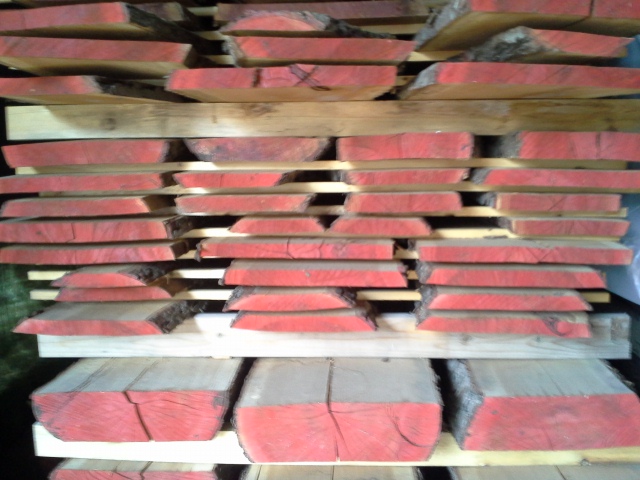Sawing a Cherry Log for Value
Without a specific project in mind, a woodworker asks how to best saw a nice Cherry log in a way that leaves his options open. September 18, 2014
Question (WOODWEB Member) :
A sawyer friend of mine called and has a 34" diameter cherry log that's about 14' long with no visible knots. He will saw it, however I want to dry it there for about $2.75bf. I don't have an immediate project in mind, and can't decide how to saw it. I have never been involved in this side of the process, so I was hoping for a bit of advice.
Forum Responses
(Sawing and Drying Forum)
From Contributor J:
It does kind of depend on your future use. That being said, we sometimes will flitch saw logs for our own use, stacking each piece in order so everything is bookmatched. This also gives you a combination of flatsawn and quartersawn lumber, and the option of using live edges in a project. If later on we don't need the live edge we just straight line edges in the shop. Thickness wise, I would consider a mix of some 4/4 and either 8 or 10/4. That can always be re-sawn into thinner stock. Maybe even some 16/4 for table legs, etc. Unless he's got a pretty good size saw you may not be able to do this for the widest part of the 34" log, but you could still do a lot of it like this.

Click here for higher quality, full size image
From Contributor E:
Put Anchorseal or the equivalent on the ends of the log asap. This will reduce defects a lot and improve the quality of the boards.
From contributor Y:
You do understand that you're looking at about 600 board feet, and that it will cost $1,650? That's assuming that the log is solid. To expand on Contributor J's good advice, I'd suggest cutting the 4/4 boards 1-1/8" thick so that you can get 3/4" thick boards after drying and planing. If it were my log, I'd cut it into two 7' long pieces. The lumber will be easier to handle, and you'll get better yield from the log. Not many woodworking projects need 14' long boards. Finally, get the ends coated (Anchorseal is best, but latex paint helps) to keep down the end checking. You want every inch of every board in that log!
From Contributor B:
An option would be to level the height of the pith from one end to the other, then saw flat from the top down to about 4" (or whatever you would prefer) from the pith; flip the log 180 degrees and do the same; then flip it 90 degrees and saw top to bottom in 1-2" slices (again, to your wanting) to create building wood for the previously cut slabs. The outer pieces will be more figured, the inner straighter grains. There will be a few issues with kiln drying, you will appreciate a good kiln operator if you go there. This method develops nice pieces for tables. Whatever you do, best of luck!
From contributor S:
You've already received advice so I can't add much, but I'd recommend sawing the thickest lumber you can from this log. At 34" width, you will end up with many wide boards. Thinner cherry boards like to curl and warp, especially if the log has grown in tension or has any kind of stress. At 28" wide, even 8/4 cherry may curl. So go with 10/4 or more and plan to re-saw. I've cut 8/4 with 1/16" over on my mill and I have found this to be a bit too thin to do reliable re-saws of anything wider than about 15". If wider than this the "ears" and "bellies" often need to be shaved to remove cup. Take a good look at the log if you can. If you can see any sweep to it (long curve, like a banana), then have the sawyer cut your thinner boards from the sides. If you can, butt them up against each other as they are cut, and put together a tight bundle. Steel strap it in multiple places.
When they dry, these will try to curve the same way as the log sweep, but the tight bundling will keep them mostly straight. With luck, you can straighten them up with a straight line rip. Stick properly as soon as it's cut, 1" sticks - no thinner. Do not dead stack for even a few days. Mold will result. Keep out of sunlight to avoid greying/discoloration. A 34" cherry log is a special thing. You're very lucky to know a sawyer like that.
From the original questioner:
Thanks everyone for some thoughtful responses. The log is straight and clear. There is a crotch section on another shorter log that I am slabbing through and through. I like the idea of thicker material to re-saw later, but that sure will increase the dry time. I have to do something pretty soon though!
